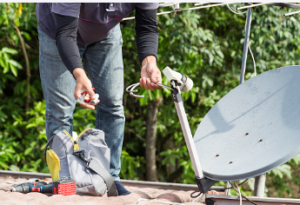Category: Home Appliances
Antenna Installation – Do it Yourself
July 28, 2022
Before you begin TV antenna installation, you should ensure that your television accepts a coax cable. This cable links the antenna and the television or tuner box. Before connecting the antenna to the TV or tuner box, you’ll need to scan for channels. Then, hook up the coax cable to the antenna. Next, follow the instructions that come with the coax cable. Finally, connect the antenna to your television, and you’re all set!
 If you’re looking for an excellent antenna installation Adelaide job, you’ve come to the right place. We’ll cover Safety considerations, tools needed and installing an antenna. In addition, we’ll cover the costs and guidelines. So please read on to find out how to do it yourself safely. Here’s a handy guide. It’ll save you time and money! Listed below are some of the critical things you’ll need to know.
If you’re looking for an excellent antenna installation Adelaide job, you’ve come to the right place. We’ll cover Safety considerations, tools needed and installing an antenna. In addition, we’ll cover the costs and guidelines. So please read on to find out how to do it yourself safely. Here’s a handy guide. It’ll save you time and money! Listed below are some of the critical things you’ll need to know.
Cost of antenna installation
The cost of antenna installation is relatively inexpensive. The average antenna lasts between 10 and 15 years when installed properly. A well-installed antenna, however, is essential for signal integrity. The weakest link in any antenna system can result in a loss of signal integrity, leading to a costly overhaul of the entire system. Even a newer building with the same antenna might need an overhaul, but an old one might not.
An outdoor antenna installation costs person-hours, a medium-sized antenna, and transmission cables. It also includes mounting hardware and grounding materials. However, the cost does not include:
- A satellite TV or cable subscription.
- Signal boosters.
- Telescoping or rotor antennas.
- Commercial-grade antennas.
- Other specialty antennas.
The price may be higher or lower depending on factors such as your local weather, location, and antenna quality.
Safety considerations
There are many safety considerations when installing an antenna, including avoiding overhanging branches and hornets’ nests. Also, wear appropriate clothing and footwear for weather conditions and flexible protective gloves. If your antenna is installed on a tall mast that’s 15 feet or higher, at least one person should do the installation. Finally, always read the installation instructions before starting and don’t take any shortcuts.
Before starting, ensure the antenna’s full vertical position is secure, and the area is well-ground. If you’re working on a roof, ensure there are no broken shingles or other potential weak spots. Consider the effect of sudden rain or high winds. Also, ensure a good safety belt while working on an antenna. In the case of a lightning strike, immediately remove the person from the area before they get shocked.
Tools needed
You will need a few tools to complete the task regardless of the antenna type. A ladder, a harness, and a coax cable are all critical for antenna installation Adelaide. Other materials you will need include screws, a mount, and cable, as well as splitters and cable ties. Depending on your antenna type, you may also need a hand-held GPS or Super Buddy to help you navigate.
For the most accurate installation, qualified persons are required. While walkie-talkies and other communication tools are essential, other tools can make the job easier. Walkie-talkies are an excellent communication tool, and Apple devices come with FaceTime, which is helpful for video calls. A television suitable for antenna installation Adelaide is also necessary. A “kinda-sorta” TV will not do, as it does not have a digital tuner that converts the digital signal into analog picture and sound.
Safety guidelines
When installing an antenna, safety should always come first. Before you begin the work:
- Gather the right tools and personal protective equipment.
- Before beginning, check the area for any potential weak spots or damaged shingles.
- Remember that antennas are susceptible to sudden rain or wind damage, so use caution when working with these factors.
A well-insulated ladder is an integral part of antenna safety. A metal ladder is also an excellent choice.
Antennas may not comply with the CSA standard, so be sure to read instructions carefully. Insulation protects against high voltages but cannot withstand them forever. While some antennas are insulated, the antenna mast should not be. Even if the antenna is appropriately insulated, contact with power lines could still lead to electrocution. Therefore, you should avoid installing antennas near power lines.
If you are unsure of how to install an antenna, don’t be afraid to call in a professional. Antenna installation requires experience and skills. Local pros can help you choose the proper location for the antenna and run the cable, ensuring that it is grounded properly